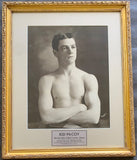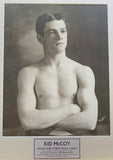MCCOY, KID ORIGINAL LARGE FORMAT PHOTOGRAPH
Size
Regular price $15,000.00
HISTORY: Charles "Kid" McCoy (October 13, 1872 – April 18, 1940), born Norman Selby, was an American world champion boxer and early Hollywood actor. Tommy Ryan was knocked out by Kid McCoy in the 15th round on March 2, 1906. This bout forms part of the lore of the McCoy legend. McCoy served as a sparring partner for Ryan, and absorbed many beatings at the hands of his employer. Ryan was notorious for showing little mercy to his sparring partners. As a result, McCoy hated Ryan, and sought revenge. It is alleged that McCoy, who appeared thin, pale and frail, persuaded Ryan that he was seriously ill before their fight. McCoy, who was famed as a trickster, purportedly rubbed flour on his face so as to appear deathly ill. Ryan is said to have fallen for the ruse, failed to train properly and was not in top condition for the bout. Whether true or not, McCoy scored an upset win over Ryan in the non-title match Another one of McCoy's tactics was demonstrated while McCoy was on a tour of Australia and some other Pacific Islands. To supplement his income, he would take on all comers. In one unidentified port, McCoy, who scarcely weighed 160 pounds (73 kg), agreed to box a huge native reputed to weigh in excess of 250 pounds (110 kg). McCoy watched him train and noted the man fought in his bare feet. When the fight began, McCoy's corner threw handfuls of tacks into the ring, causing the bare-footed challenger to drop his guard and raise up one foot. As soon as he did so, McCoy lowered the boom on his distracted adversary. Although slight of build, McCoy captured the world middleweight championship by defeating Dan Creedon. McCoy never defended the title, choosing to abandon the crown to enable him to pursue the world heavyweight championship. Despite his handicap in size, McCoy battled the best heavyweights of his era, and defeated Joe Choynski and Peter Maher. He was defeated by Tom Sharkey and Jim Corbett. The Corbett fight was the subject of controversy, as the ending was suspect and Corbett's estranged wife claimed the bout was fixed. McCoy's career was no less colorful outside the ring. He was married ten times, performed in theater, and went west to California during the birth of the movie industry there. He appeared in films, including a scene fighting Wallace Reid in the 1922 film, The World's Champion. McCoy was also friends with many movie stars of the day, including Charles Chaplin and director D.W. Griffith, who directed the 1919 silent film, Broken Blossoms, Selby's second film as actor. Unfortunately, by the early 1920s McCoy was poor, addicted to alcohol and out of the movie industry. At this time however, McCoy was involved in a romance with a wealthy married woman, Teresa Mors. Apparently he swept her off her feet, for she filed for divorce from her husband. The Mors divorce was acrimonious, and dragged on until she was killed, in the apartment she shared with McCoy at 2819 Leeward (Unit 212), by a single gunshot to the head on August 12, 1924. The next morning, a disheveled McCoy robbed and held captive some 12 people at Mrs. Mors' antique shop, and shot one man, who was trying to escape, in the leg. He also had forced at least six other men to remove their trousers, after divesting them of their money. McCoy was apprehended and charged with the murder of Mrs. Mors. His trial took place in downtown Los Angeles, and was the media event of its day. McCoy claimed Mrs. Mors committed suicide, while the prosecution claimed he murdered her for financial gain. McCoy testified in his own defense, and apparently put on quite a show as he demonstrated Mrs. Mors final minutes. Contending he had tried to wrestle a knife away from her, McCoy and his attorney actually wrestled and rolled around on the courtroom floor, for the benefit of the jury, press and courtroom spectators. After Mrs. Mors allegedly took her own life, McCoy claimed he became faint and could not remember anything further, including participating in the wild crime spree the following morning. Dagmar Dahlgren was the eighth wife of McCoy. Dahlgren and McCoy had lived together for three days. Dahlgren disputed one of McCoy's alibis during his trial. Specifically she denied to her attorney that she had seen him in the two years prior to Mors' death. Apparently, the jury was split between first degree murder and acquittal. In what is believed to have been a compromise verdict, McCoy was convicted of manslaughter. McCoy was sent to San Quentin, but was paroled from prison in 1932. Afterwards he worked for Ford Motor Company. McCoy took his own life in Detroit on April 18, 1940. Even his death was enigmatic. He committed suicide at the Hotel Tuller in Detroit by an overdose of sleeping pills, leaving a note behind. It read, among other things "Everything in my possession, I want to go to my dear wife, Sue E. Selby ... To all my dear friends ... best of luck ... sorry I could not endure this world's madness. Norman Selby." In an apparent last attempt to drop his professional moniker, the note was pointedly signed as, "Norman Selby." Presented here is an original, first generation, large format, albumen photograph of Kid McCoy as he looked at the height of his career
FULL DESCRIPTION: This is an original, first generation, large format, albumen photograph of Kid McCoy as he looked at the height of his career. Photographer stamp at lower right for Mamenis. Bold, clear image. Not creased or torn. Clean without staining. Minor surface wear. Professionally framed and matted. Photo is 12" x 15" framed to 18" x 22." Exceedingly rare and likely unique. The finest photo of Kid McCoy we have seen or offered.
Size: 12" x 15"
Condition: Excellent




